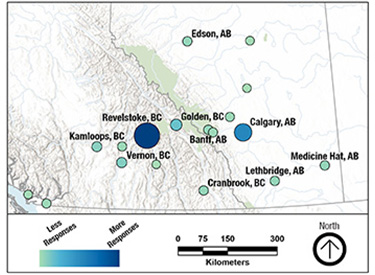
2021 Draft plan review: what we heard
Mount Revelstoke National Park
- Download the PDF version (633 KB) (PDF, 633 KB)
THE ENGAGEMENT PROCESS
Table of contents
Summary of engagement activities
The development of a draft management plan for Mount Revelstoke and Glacier national parks and Rogers Pass National Historic Site was informed through consultation with Indigenous partners, stakeholders and the general public in 2019. In 2021, the draft plan was shared with these same audiences for review. Feedback strengthened the final plan and is reflected in the vision, key strategies, objectives and targets.
Consultation with Indigenous partners, the public and stakeholders ran in parallel with a variety of approaches based on the different needs, interests and rights of diverse groups. The planning process and public engagement was coordinated with the other mountain parks (Banff, Yoho, Kootenay, Jasper and Waterton Lakes), as these places share many of the same challenges, opportunities, stakeholders and visitors. All of the mountain parks used the Let’s Talk Mountain Parks webpages as the backdrop for public engagement.


In the first phase of public engagement, Parks Canada reached out broadly to capture wide-ranging views on the future of these special places. Engagement in the second phase was more focused, with more time for participants to review and provide meaningful comments on the draft management plan. The draft plan review was predominantly online due to COVID-19 health and safety considerations, and included a virtual open house and several topic specific virtual workshops. In total, Parks Canada team members spoke directly with approximately 137 people through these public meetings.
Through social media advertising all Canadians were invited to submit their input on the draft management plan on the Mount Revelstoke and Glacier pages of the Let’s Talk Mountain Parks website. Over 4000 people visited the pages between April and July 2021, and 222 submissions were received.
Over both phases of public engagement, Parks Canada team members spoke directly with more than 657 people, the Mount Revelstoke and Glacier pages of Let’s Talk Mountain Parks were visited by over 8,700 Canadians and a total of 448 online submissions were received. A wide variety of ideas, issues and opportunities were shared, both in person and online, ranging from broad landscape-level conservation to specific operational input. All feedback was considered in drafting, revising and completing the management plan for Mount Revelstoke and Glacier national parks and Rogers Pass National Historic Site.
Who we heard from

MAP – Geographical distribution of website participants from Western Canada— Text version
A map of British Columbia and Alberta showing the geographical distribution of website participants from Western Canada. The map is a 0 – 300 km scale. A large dark blue circle shows most respondents were from Revelstoke, followed by Calgary with a slightly smaller circle. Small circles also show respondents from the coast in BC through to Medicine Hat and North to Edson in Alberta. Other labels include Vernon, Kamloops, Golden and Cranbrook in BC, and Banff and Lethbridge in Alberta.
Indigenous partners were invited from the start of the process to share their views on the future of the parks. Input was received from the Ktunaxa Nation Council, the syilx/Okanagan Nation, and five Secwépemc bands: Adams Lake, Little Shuswap Lake, Neskonlith, Shuswap, and Splatsin.
Feedback on the draft management plan content on the Let’s Talk Mountain Parks webpages was almost exclusively from residents of British Columbia (60%) and Alberta (35%). The majority of those respondents were from Revelstoke (36%) and Calgary (20%). Virtual sessions were attended by local and regional representatives from tourism and conservation organizations as well as interested community members. More detailed feedback was also received from the Canadian Parks and Wilderness Society (CPAWS) and Yellowstone to Yukon Conservation Initiative (Y2Y).
WHAT WE HEARD
Input received during consultation on the draft management plan has been reviewed and incorporated in the final plan. Amendments to the final management plan respond to what we heard throughout the engagement process.
What we heard from Indigenous peoples
Strong relationships with Indigenous partners are essential to Parks Canada’s work and contribute to the process of reconciliation between Indigenous peoples, the Government of Canada, and other Canadians, based on the recognition of rights, respect, co-operation, and partnership. Park Management discussions with the Indigenous peoples whose traditional territories include Mount Revelstoke and Glacier national parks are ongoing and will help guide decision-making into the future. Input received to date provided guidance for strengthening the management plan vision, objectives and targets including:
- Ensuring that Indigenous partners are engaged in park management in ways that are meaningful to them based on their values, knowledge, perspectives, priorities, and capacity. This includes removing arbitrary time constraints on Indigenous relations targets.
- Broadening the focus beyond species at risk conservation to include species of traditional and cultural significance, and proactive conservation efforts to prevent species from becoming at risk.
What we heard from stakeholders and the public
Overall, there was strong support for the draft management plan as presented for public review in 2021. Input received focused largely on refining specific objectives or targets within the key strategies and management areas. All comments, suggestions and concerns expressed through the online platform, virtual sessions and email submissions were considered in finalizing the park management plan.
Vision
There were very few comments on the vision statement. Those received were largely supportive with minor wording suggestions. It was suggested that the vision needed a more “nature-positive” focus as it seemed to prioritize the human experience in the parks and site.
In general, respondents were supportive of the focus on four key strategies. It was suggested that the plan have separate key strategies for climate change, and regional connectivity and landscapes as presented in some of the other mountain national park plans.Key strategies
In general, respondents were supportive of the focus on four key strategies. It was suggested that the plan have separate key strategies for climate change, and regional connectivity and landscapes as presented in some of the other mountain national park plans.
Taking feedback into consideration, it was decided to increase the profile of climate change and landscape connectivity in the plan and strengthen the objectives and targets within the existing strategies, thereby maintaining an integrated approach.
Key Strategy #1: Conserving Natural and Cultural Heritage for Future Generations
This key strategy received the most comments during public engagement and respondents were largely supportive. A few people wanted to see more focus on the cultural heritage with specific reference to human access and mountaineering culture.
Within the comments there was a split between those who wanted to see limited access to increase protection versus those who wanted increased access for enjoyment of the parks. Polarized views were also expressed in terms of those for and against caribou conservation measures, and the use of prescribed fire in the parks.
Some respondents wanted to see more strategic and action-based language for climate change targets as well as for human-wildlife coexistence measures.
There was support for increased collaboration with partners and stakeholders as well as volunteers but with clear descriptions of how priorities were identified and what the reciprocal benefits were.
It was noted that Indigenous involvement first requires engagement to determine how they want to be involved.
How this feedback was considered
- A new target was added to identify collaboration with Indigenous partners in ecological monitoring.
- Wording was adjusted to some objectives and targets better reflect the proposed outcomes.
- Targets remain focused on measurable results. Actions to achieve these targets will be determined at an operational level and reflect current circumstances, capacity and priorities. Action plans may involve public engagement, and will be reported on annually to highlight progress toward achieving management plan objectives and targets.
Key Strategy #2: True to Place Experiences
Overall, there was support for this strategy. Most respondents acknowledged the need to address increasing visitation, and wanted this to be a priority. It was suggested that some targets were conflicting or ambiguous. Concern was expressed for every target that suggested promoting visitation. There were many comments expressing concern about encouraging bus tours, unless used as a means to reduce traffic.
As in Key Strategy #1, there were conflicting views related to access (more vs. less) with a primary focus on winter activities in Glacier National Park.
Several respondents wanted to see more focus and investments on backcountry access including winter trailhead parking, and summer backcountry campgrounds, facilities, and trails.
It was noted that Indigenous stories were missing from this strategy.
Several comments focused specifically on the winter offer in Glacier National Park and expressed concern about fee implementation for the Winter Permit System both in terms of affecting compliance and unduly singling out winter backcountry users for additional fees.
How this feedback was considered
- This strategy was reorganized to ensure the targets were clear and well aligned with each objective.
- Amendments put a stronger focus on managing increasing visitation, reducing environmental impacts, and improving visitor programs and services.
- The focus was kept broad for a year round approach. Seasonal variances in visitation patterns and trends would be captured in operational action plans and strategies like the proposed “backcountry use strategy”.
Key Strategy #3: Strengthening Indigenous Relations
While largely supported, this strategy did have more “do not support” responses in the online comments than other strategies. Several responses had opposing viewpoints on the proposed direction and many questions were raised about how the objectives and targets would be implemented. One comment raised by several respondents was that the Sinixt peoples should be explicitly referenced in this strategy.
How this feedback was considered
Amendments to this strategy were based on input from Indigenous partners whose traditional territories include Mount Revelstoke and Glacier national parks.
An additional introductory paragraph includes reference to Parks Canada’s commitment to support the implementation of the recommendations of the Truth and Reconciliation Commission, and the United Nations Declaration on the Rights of Indigenous Peoples, through collaboration with Indigenous partners.
- Time constraints were removed from targets to acknowledge that progress will be dependent on the priorities, interests and capacity of both Indigenous partners and Parks Canada.
Key Strategy #4: Crossing the Columbias – Transportation, Assets and Infrastructure
This strategy received considerable support overall. Many respondents wanted to see key concerns addressed around highway safety, particularly reducing speed and improving wildlife safety; and parking for both trailheads and during road closures including the availability of basic amenities for these areas. Other concerns raised were largely focused on Trans-Canada Highway twinning.
How this feedback was considered
Very few edits were made to this strategy other than to shift focus from highway twinning to broader highway improvements. This is to acknowledge that public and wildlife safety improvements, environmental protection mitigations and visitor experience enhancements can and should be considered during any highway construction. Data collection, investigations and other planning processes outlined in this strategy would ultimately contribute to a highway twinning project, but that work specifically is outside the scope of this management plan.
Management areas
The majority of respondents agreed that the three areas identified were appropriate as management areas to address unique challenges and opportunities.
Meadows in the Sky: From Columbia River Valley to Alpine Headwaters
Most people thought the description accurately reflected what is unique and important about the area. The objectives and targets for this area were also largely supported. Some respondents wanted to see more immediate action on managing visitor use reflected in the plan.
How this feedback was considered
Based on feedback received, very few edits were made to the Management Areas section of the plan. The only notable changes were to broaden the audience to regional communities instead of local and to create an additional target for Indigenous partners for the Meadows in the Sky management area.
Rogers Pass National Historic Site
The description of what is unique and important in this area was supported. Areas for improvement were primarily related to cultural heritage including more emphasis on the railway, mountaineering, and guiding history of the area.
Response to the objectives and targets was positive. Many comments were received on the topic of new overnight options for Rogers Pass, both for and against new development. There was strong support for sharing the history of the pass and establishing Rogers Pass as a hub for scientific learning and research.
Beaver Valley
There was strong support for this management area description and its objectives and targets. Most respondents wanted to see this area opened up for multi-day backcountry use, but managed appropriately by Parks Canada to protect its wilderness values. Collaboration with key stakeholder groups was also encouraged.
A PLAN FOR THE FUTURE
The 2022 Management Plan for Mount Revelstoke and Glacier national parks and Rogers Pass National Historic Site takes into consideration all of the comments and suggestions received through consultation with Indigenous and regional partners, stakeholders, local community members and the general public. While still a high-level strategic document, language in the final plan reflects the input received throughout the management planning process.
The key strategies in this plan will guide park management for the next 10 years as we work together to achieve our shared vision. Actions to achieve the plan’s objectives will ensure that we continue to maintain and/or improve ecological integrity, visitor experience, our relationships with Indigenous partners and local communities, and foster meaningful connections with generations of Canadians.
While the management planning process is now complete, Parks Canada will provide annual implementation updates to partners, stakeholders and the general public, and is always open to receiving feedback and suggestions for ways we can work with others to achieve shared objectives.
- Date modified :